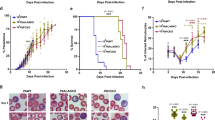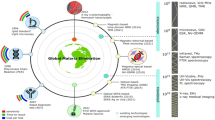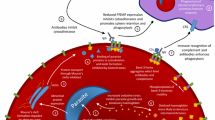Abstract
Purpose of Review
Malaria is a disease caused by parasites that reside in host red blood cells and use hemoglobin as a nutrient source. Heme released by hemoglobin catabolism is modified by the parasite to produce hemozoin (HZ), which has toxic effects on the host. Experimentation aiming to elucidate how HZ contributes to malaria pathogenesis has utilized different preparations of this molecule, complicating interpretation and comparison of findings. We examine natural synthesis and isolation of HZ and highlight studies that have used multiple preparations, including synthetic forms, in a comparative fashion.
Recent Findings
Recent work utilizing sophisticated imaging and detection techniques reveals important molecular characteristics of HZ synthesis and biochemistry. Other recent studies further refine understanding of contributions of HZ to malaria pathogenesis yet highlight the continuing need to characterize HZ preparations and contextualize experimental conditions in the in vivo infection milieu.
Summary
This review highlights the necessity of collectively determining what is physiologically relevant HZ. Characterization of isolated natural HZ and use of multiple preparations in each study are recommended with application of in vivo studies whenever possible. Adoption of such practices is expected to improve reproducibility of results and elucidate the myriad of ways that HZ participates in malaria pathogenesis.
Similar content being viewed by others
References
Papers of particular interest, published recently, have been highlighted as: • Of importance •• Of major importance
WHO, World Malaria Report 2020. 2020, World Health Organization
Brasil P, Zalis MG, de Pina-Costa A, Siqueira AM, Júnior CB, Silva S, et al. Outbreak of human malaria caused by Plasmodium simium in the Atlantic Forest in Rio de Janeiro: a molecular epidemiological investigation. Lancet Glob Health. 2017;5(10):e1038–46.
White NJ, Pukrittayakamee S, Hien TT, Faiz MA, Mokuolu OA, Dondorp AM. Malaria. Lancet. 2014;383(9918):723–35.
Thawani N, Tam M, Bellemare MJ, Bohle DS, Olivier M, de Souza JB, et al. Plasmodium products contribute to severe malarial anemia by inhibiting erythropoietin-induced proliferation of erythroid precursors. J Infect Dis. 2014;209(1):140–9.
WHO. Severe and complicated malaria. World Health Organization, Division of Control of Tropical Diseases. Trans R Soc Trop Med Hyg. 1990;84(Suppl 2):1–65.
Brabin BJ, Romagosa C, Abdelgalil S, Menéndez C, Verhoeff FH, McGready R, et al. The sick placenta-the role of malaria. Placenta. 2004;25(5):359–78.
Pham TT, et al., Hemozoin in malarial complications: more questions than answers. Trends Parasitol, 2020.
Parroche P, Lauw FN, Goutagny N, Latz E, Monks BG, Visintin A, et al. Malaria hemozoin is immunologically inert but radically enhances innate responses by presenting malaria DNA to Toll-like receptor 9. Proc Natl Acad Sci U S A. 2007;104(6):1919–24.
Coban C, Ishii KJ, Kawai T, Hemmi H, Sato S, Uematsu S, et al. Toll-like receptor 9 mediates innate immune activation by the malaria pigment hemozoin. J Exp Med. 2005;201(1):19–25.
Raulf MK, et al. The C-type lectin receptor CLEC12A recognizes plasmodial hemozoin and contributes to cerebral malaria development. Cell Rep. 2019;28(1):30–38 e5 In vitro work with sHZ reveals a specific interaction with both human and murine myeloid inhibitory C-type lectin-like receptor (CLEC12A), which promotes dendritic cell oxidative burst and cross-priming of CD8+ T cells. In vivo work confirms a key role for this interaction, presumably via nHZ, as CLEC12A-/- mice are protected against the development of P. berghei ANKA-induced cerebral malaria.
Yamada KA, Sherman IW. Plasmodium lophurae: composition and properties of hemozoin, the malarial pigment. Exp Parasitol. 1979;48(1):61–74.
Slater AF, Swiggard WJ, Orton BR, Flitter WD, Goldberg DE, Cerami A, et al. An iron-carboxylate bond links the heme units of malaria pigment. Proc Natl Acad Sci U S A. 1991;88(2):325–9.
Schwarzer E, Turrini F, Ulliers D, Giribaldi G, Ginsburg H, Arese P. Impairment of macrophage functions after ingestion of Plasmodium falciparum-infected erythrocytes or isolated malarial pigment. J Exp Med. 1992;176(4):1033–41.
Casals-Pascual C, Kai O, Cheung JOP, Williams S, Lowe B, Nyanoti M, et al. Suppression of erythropoiesis in malarial anemia is associated with hemozoin in vitro and in vivo. Blood. 2006;108(8):2569–77.
Schwarzer E, Kühn H, Valente E, Arese P. Malaria-parasitized erythrocytes and hemozoin nonenzymatically generate large amounts of hydroxy fatty acids that inhibit monocyte functions. Blood. 2003;101(2):722–8.
Jaramillo M, Godbout M, Olivier M. Hemozoin induces macrophage chemokine expression through oxidative stress-dependent and -independent mechanisms. J Immunol. 2005;174(1):475–84.
Jaramillo M, Gowda DC, Radzioch D, Olivier M. Hemozoin increases IFN-gamma-inducible macrophage nitric oxide generation through extracellular signal-regulated kinase- and NF-kappa B-dependent pathways. J Immunol. 2003;171(8):4243–53.
Dasari P, Bhakdi S. Pathogenesis of malaria revisited. Med Microbiol Immunol. 2012;201(4):599–604.
Dasari P, Reiss K, Lingelbach K, Baumeister S, Lucius R, Udomsangpetch R, et al. Digestive vacuoles of Plasmodium falciparum are selectively phagocytosed by and impair killing function of polymorphonuclear leukocytes. Blood. 2011;118(18):4946–56.
Barrera V, Skorokhod OA, Baci D, Gremo G, Arese P, Schwarzer E. Host fibrinogen stably bound to hemozoin rapidly activates monocytes via TLR-4 and CD11b/CD18-integrin: a new paradigm of hemozoin action. Blood. 2011;117(21):5674–82.
Keller CC, Kremsner PG, Hittner JB, Misukonis MA, Weinberg JB, Perkins DJ. Elevated nitric oxide production in children with malarial anemia: hemozoin-induced nitric oxide synthase type 2 transcripts and nitric oxide in blood mononuclear cells. Infect Immun. 2004;72(8):4868–73.
Keller CC, Hittner JB, Nti BK, Weinberg JB, Kremsner PG, Perkins DJ. Reduced peripheral PGE2 biosynthesis in Plasmodium falciparum malaria occurs through hemozoin-induced suppression of blood mononuclear cell cyclooxygenase-2 gene expression via an interleukin-10-independent mechanism. Mol Med. 2004;10(1-6):45–54.
Lucchi NW, Sarr D, Owino SO, Mwalimu SM, Peterson DS, Moore JM. Natural hemozoin stimulates syncytiotrophoblast to secrete chemokines and recruit peripheral blood mononuclear cells. Placenta. 2011;32(8):579–85.
Deroost K, Lays N, Pham TT, Baci D, van den Eynde K, Komuta M, et al. Hemozoin induces hepatic inflammation in mice and is differentially associated with liver pathology depending on the Plasmodium strain. PLoS One. 2014;9(11):e113519.
Deroost K, Lays N, Noppen S, Martens E, Opdenakker G, van den Steen PE. Improved methods for haemozoin quantification in tissues yield organ-and parasite-specific information in malaria-infected mice. Malar J. 2012;11:166.
Corbett Y, D’Alessandro S, Parapini S, Scaccabarozzi D, Kalantari P, Zava S, et al. Interplay between Plasmodium falciparum haemozoin and L-arginine: implication for nitric oxide production. Malar J. 2018;17(1):456.
Guerra ED, et al. What is pure hemozoin? A close look at the surface of the malaria pigment. J Inorg Biochem. 2019;194:214–22 Using a range of washing techniques with varying degrees of stringency, the surface of P. falciparum-derived HZ is examined by x-ray photoelectron spectroscopy and matrix-assisted laser desorption/ionization time of flight. The analysis shows that while some contaminants are introduced during isolation, proteins, carbohydrates and lipids, but not nucleic acids, are present on the HZ surface, binding via carboxylate groups.
Guerra ED, et al. Inorganic ions on hemozoin surface provide a glimpse into Plasmodium biology. J Inorg Biochem. 2019;200:110808 X-ray photoelectron spectroscopy, scanning electron microscopy, and energy-dispersive X-ray spectroscopy are used to characterize elemental components on the surface of HZ from cultured P. falciparum and macrophages from P. chabaudi-infected mice. Ca and Si adhere strongly to the surface of HZ and may be introduced during crystal formation. Na, Cl, and P adhere weakly, and may be introduced during exit of HZ from the iRBC.
Knackstedt SL, et al. Neutrophil extracellular traps drive inflammatory pathogenesis in malaria. Sci Immunol. 2019;4(40):eaaw0336 This work proposes that it is heme and not DVs, iRBCs or merozoites that drive NETosis in malaria. Also demonstrated are NET-driven intercellular adhesion molecule-1 endothelial upregulation and production of granulocyte colony-stimulating factor as mediators of inflammation.
Harding CL, et al. Plasmodium impairs antibacterial innate immunity to systemic infections in part through hemozoin-bound bioactive molecules. Front Cell Infect Microbiol. 2020;10:328 In comparing several different preparations of HZ, this work demonstrates a key role for protein and lipid components, but not DNA, associated with nHZ in influencing the ability of mice to control orally- and nasally-acquired bacterial infections.
Simpson JA, Silamut K, Chotivanich K, Pukrittayakamee S, White NJ. Red cell selectivity in malaria: a study of multiple-infected erythrocytes. Trans R Soc Trop Med Hyg. 1999;93(2):165–8.
Francis SE, Sullivan DJ Jr, Goldberg DE. Hemoglobin metabolism in the malaria parasite Plasmodium falciparum. Annu Rev Microbiol. 1997;51:97–123.
Goldberg DE. Hemoglobin degradation in Plasmodium-infected red blood cells. Semin Cell Biol. 1993;4(5):355–61.
Goldberg DE, Slater AF, Cerami A, Henderson GB. Hemoglobin degradation in the malaria parasite Plasmodium falciparum: an ordered process in a unique organelle. Proc Natl Acad Sci U S A. 1990;87(8):2931–5.
Zarchin S, Krugliak M, Ginsburg H. Digestion of the host erythrocyte by malaria parasites is the primary target for quinoline-containing antimalarials. Biochem Pharmacol. 1986;35(14):2435–42.
Miller LH, Baruch DI, Marsh K, Doumbo OK. The pathogenic basis of malaria. Nature. 2002;415(6872):673–9.
Ashong JO, Blench IP, Warhurst DC. The composition of haemozoin from Plasmodium falciparum. Trans R Soc Trop Med Hyg. 1989;83(2):167–72.
Jani D, Nagarkatti R, Beatty W, Angel R, Slebodnick C, Andersen J, et al. HDP-a novel heme detoxification protein from the malaria parasite. PLoS Pathog. 2008;4(4):e1000053.
Elphinstone RE, Conroy AL, Hawkes M, Hermann L, Namasopo S, Warren HS, et al. Alterations in systemic extracellular heme and hemopexin are associated with adverse clinical outcomes in Ugandan children with severe malaria. J Infect Dis. 2016;214(8):1268–75.
Elphinstone RE, Riley F, Lin T, Higgins S, Dhabangi A, Musoke C, et al. Dysregulation of the haem-haemopexin axis is associated with severe malaria in a case-control study of Ugandan children. Malar J. 2015;14:511.
Kapishnikov S, et al., Malaria Pigment Crystals, the Achilles Heel of the Malaria Parasite. ChemMedChem, 2021. In this article, data from X-ray and electron microscopy are used to propose a novel model for HZ nucleation at the DV membrane, with ordered addition of hematin dimers and release of some crystals to the aqueous organellar lumen, free of lipids. Relevance for antimalarial drugs targeting this process is reviewed.
Slater AF, Cerami A. Inhibition by chloroquine of a novel haem polymerase enzyme activity in malaria trophozoites. Nature. 1992;355(6356):167–9.
Egan TJ, Ross DC, Adams PA. Quinoline anti-malarial drugs inhibit spontaneous formation of beta-haematin (malaria pigment). FEBS Lett. 1994;352(1):54–7.
Chugh M, Sundararaman V, Kumar S, Reddy VS, Siddiqui WA, Stuart KD, et al. Protein complex directs hemoglobin-to-hemozoin formation in Plasmodium falciparum. Proc Natl Acad Sci U S A. 2013;110(14):5392–7.
Sullivan DJ Jr. I.Y. Gluzman, and D.E. Goldberg, Plasmodium hemozoin formation mediated by histidine-rich proteins. Science. 1996;271(5246):219–22.
Pandey AV, Babbarwal VK, Okoyeh JN, Joshi RM, Puri SK, Singh RL, et al. Hemozoin formation in malaria: a two-step process involving histidine-rich proteins and lipids. Biochem Biophys Res Commun. 2003;308(4):736–43.
Carney CK, Schrimpe AC, Halfpenny K, Harry RS, Miller CM, Broncel M, et al. The basis of the immunomodulatory activity of malaria pigment (hemozoin). J Biol Inorg Chem. 2006;11(7):917–29.
Arese P, Schwarzer E. Malarial pigment (haemozoin): a very active 'inert' substance. Ann Trop Med Parasitol. 1997;91(5):501–16.
Levesque MA, Sullivan AD, Meshnick SR. Splenic and hepatic hemozoin in mice after malaria parasite clearance. J Parasitol. 1999;85(3):570–3.
Frita R, et al. In vivo hemozoin kinetics after clearance of Plasmodium berghei infection in mice. Malar Res Treat. 2012;2012:373086.
Boura M, Frita R, Góis A, Carvalho T, Hänscheid T. The hemozoin conundrum: is malaria pigment immune-activating, inhibiting, or simply a bystander? Trends Parasitol. 2013;29(10):469–76.
Whitten R, Milner DA Jr, Yeh MM, Kamiza S, Molyneux ME, Taylor TE. Liver pathology in Malawian children with fatal encephalopathy. Hum Pathol. 2011;42(9):1230–9.
Lamikanra AA, Theron M, Kooij TWA, Roberts DJ. Hemozoin (malarial pigment) directly promotes apoptosis of erythroid precursors. PLoS One. 2009;4(12):e8446.
Taylor WRJ, Hanson J, Turner GDH, White NJ, Dondorp AM. Respiratory manifestations of malaria. Chest. 2012;142(2):492–505.
Padua TA, Souza MC. Heme on pulmonary malaria: friend or foe? Front Immunol. 2020;11:1835.
Basilico N, Corbett Y, D' Alessandro S, Parapini S, Prato M, Girelli D, et al. Malaria pigment stimulates chemokine production by human microvascular endothelium. Acta Trop. 2017;172:125–31.
Maknitikul S, Luplertlop N, Grau GER, Ampawong S. Dysregulation of pulmonary endothelial protein C receptor and thrombomodulin in severe falciparum malaria-associated ARDS relevant to hemozoin. PLoS One. 2017;12(7):e0181674.
Maknitikul S, Luplertlop N, Chaisri U, Maneerat Y, Ampawong S. Featured Article: Immunomodulatory effect of hemozoin on pneumocyte apoptosis via CARD9 pathway, a possibly retarding pulmonary resolution. Exp Biol Med (Maywood). 2018;243(5):395–407.
Lou J, Lucas R, Grau GE. Pathogenesis of cerebral malaria: recent experimental data and possible applications for humans. Clin Microbiol Rev. 2001;14(4):810–20 table of contents.
Moxon CA, Gibbins MP, McGuinness D, Milner DA Jr, Marti M. New Insights into Malaria Pathogenesis. Annu Rev Pathol. 2020;15:315–43.
Eugenin EA, Martiney JA, Berman JW. The malaria toxin hemozoin induces apoptosis in human neurons and astrocytes: potential role in the pathogenesis of cerebral malaria. Brain Res. 2019;1720:146317.
Velagapudi R, Kosoko AM, Olajide OA. Induction of neuroinflammation and neurotoxicity by synthetic hemozoin. Cell Mol Neurobiol. 2019;39(8):1187–200.
Ngo-Thanh H, Sasaki T, Suzue K, Yokoo H, Isoda K, Kamitani W, et al. Blood-cerebrospinal fluid barrier: another site disrupted during experimental cerebral malaria caused by Plasmodium berghei ANKA. Int J Parasitol. 2020;50(14):1167–75.
Liu M, et al. Plasmodium-infected erythrocytes (pRBC) induce endothelial cell apoptosis via a heme-mediated signaling pathway. Drug Des Devel Ther. 2016;10:1009–18.
Rogerson SJ, et al. Placental monocyte infiltrates in response to Plasmodium falciparum malaria infection and their association with adverse pregnancy outcomes. Am J Trop Med Hyg. 2003;68(1):115–9.
Avery JW, Smith GM, Owino SO, Sarr D, Nagy T, Mwalimu S, et al. Maternal malaria induces a procoagulant and antifibrinolytic state that is embryotoxic but responsive to anticoagulant therapy. PLoS One. 2012;7(2):e31090.
Reis AS, et al. Inflammasome activation and IL-1 signaling during placental malaria induce poor pregnancy outcomes. Sci Adv. 2020;6(10):eaax6346.
Shio MT, et al. Malarial hemozoin activates the NLRP3 inflammasome through Lyn and Syk kinases. PLoS Pathog. 2009;5(8):e1000559.
Kalantari P, DeOliveira RB, Chan J, Corbett Y, Rathinam V, Stutz A, et al. Dual engagement of the NLRP3 and AIM2 inflammasomes by plasmodium-derived hemozoin and DNA during malaria. Cell Rep. 2014;6(1):196–210.
Liu M, Hassana S, Stiles JK. Heme-mediated apoptosis and fusion damage in BeWo trophoblast cells. Sci Rep. 2016;6:36193.
Penha-Goncalves C, Gozzelino R, de Moraes LV. Iron overload in Plasmodium berghei-infected placenta as a pathogenesis mechanism of fetal death. Front Pharmacol. 2014;5:155.
Morffy Smith CD, Russ BN, Andrew AK, Cooper CA, Moore JM. A novel murine model for assessing fetal and birth outcomes following transgestational maternal malaria infection. Sci Rep. 2019;9(1):19566.
Egan TJ. Physico-chemical aspects of hemozoin (malaria pigment) structure and formation. J Inorg Biochem. 2002;91(1):19–26.
Corbett Y, Parapini S, D'Alessandro S, Scaccabarozzi D, Rocha BC, Egan TJ, et al. Involvement of Nod2 in the innate immune response elicited by malarial pigment hemozoin. Microbes Infect. 2015;17(3):184–94.
Sherry BA, et al. Malaria-specific metabolite hemozoin mediates the release of several potent endogenous pyrogens (TNF, MIP-1 alpha, and MIP-1 beta) in vitro, and altered thermoregulation in vivo. J Inflamm. 1995;45(2):85–96.
Jaramillo M, Plante I, Ouellet N, Vandal K, Tessier PA, Olivier M. Hemozoin-inducible proinflammatory events in vivo: potential role in malaria infection. J Immunol. 2004;172(5):3101–10.
Lautenschlager SOS, et al. Plasma proteins and platelets modulate neutrophil clearance of malaria-related hemozoin crystals. Cells. 2019;9(1):93.
Bucsan AN, Williamson KC. Setting the stage: The initial immune response to blood-stage parasites. Virulence. 2020;11(1):88–103.
Lamphier MS, et al. TLR9 and the recognition of self and non-self nucleic acids. Ann N Y Acad Sci. 2006;1082:31–43.
Schwarzer E, Müller O, Arese P, Siems WG, Grune T. Increased levels of 4-hydroxynonenal in human monocytes fed with malarial pigment hemozoin. A possible clue for hemozoin toxicity. FEBS Lett. 1996;388(2-3):119–22.
Birhanu M, et al. Hematological parameters and hemozoin-containing leukocytes and their association with disease severity among malaria infected children: a cross-sectional study at Pawe General Hospital, Northwest Ethiopia. Interdiscip Perspect Infect Dis. 2017;2017:8965729.
Chua CL, et al. High numbers of circulating pigmented polymorphonuclear neutrophils as a prognostic marker for decreased birth weight during malaria in pregnancy. Int J Parasitol. 2015;45(2-3):107–11.
Kumaratilake LM, Ferrante A, Rzepczyk CM. Tumor necrosis factor enhances neutrophil-mediated killing of Plasmodium falciparum. Infect Immun. 1990;58(3):788–93.
Nnalue NA, Friedman MJ. Evidence for a neutrophil-mediated protective response in malaria. Parasite Immunol. 1988;10(1):47–58.
Sercundes MK, Ortolan LS, Debone D, Soeiro-Pereira PV, Gomes E, Aitken EH, et al. Targeting neutrophils to prevent malaria-associated acute lung injury/acute respiratory distress syndrome in mice. PLoS Pathog. 2016;12(12):e1006054.
Baker VS, Imade GE, Molta NB, Tawde P, Pam SD, Obadofin MO, et al. Cytokine-associated neutrophil extracellular traps and antinuclear antibodies in Plasmodium falciparum infected children under six years of age. Malar J. 2008;7:41.
Kho S, Minigo G, Andries B, Leonardo L, Prayoga P, Poespoprodjo JR, et al. Circulating neutrophil extracellular traps and neutrophil activation are increased in proportion to disease severity in human malaria. J Infect Dis. 2019;219(12):1994–2004.
Haque A, Best SE, Unosson K, Amante FH, de Labastida F, Anstey NM, et al. Granzyme B expression by CD8+ T cells is required for the development of experimental cerebral malaria. J Immunol. 2011;186(11):6148–56.
Nitcheu J, Bonduelle O, Combadiere C, Tefit M, Seilhean D, Mazier D, et al. Perforin-dependent brain-infiltrating cytotoxic CD8+ T lymphocytes mediate experimental cerebral malaria pathogenesis. J Immunol. 2003;170(4):2221–8.
Potter S, Chan-Ling T, Ball HJ, Mansour H, Mitchell A, Maluish L, et al. Perforin mediated apoptosis of cerebral microvascular endothelial cells during experimental cerebral malaria. Int J Parasitol. 2006;36(4):485–96.
Church J, Maitland K. Invasive bacterial co-infection in African children with Plasmodium falciparum malaria: a systematic review. BMC Med. 2014;12:31.
Mooney JP, Barry A, Gonçalves BP, Tiono AB, Awandu SS, Grignard L, et al. Haemolysis and haem oxygenase-1 induction during persistent "asymptomatic" malaria infection in Burkinabe children. Malar J. 2018;17(1):253.
Lokken KL, et al. Malaria parasite-mediated alteration of macrophage function and increased iron availability predispose to disseminated nontyphoidal Salmonella infection. Infect Immun. 2018;86(9):e00301–18.
Author information
Authors and Affiliations
Corresponding author
Ethics declarations
Human and Animal Rights and Informed Consent
This article does not contain any studies with human or animal subjects performed by any of the authors.
Conflict of Interest
The authors declare that they have no competing conflicts of interests.
Additional information
Publisher’s Note
Springer Nature remains neutral with regard to jurisdictional claims in published maps and institutional affiliations.
This article is part of the Topical Collection on Parasitology
Rights and permissions
About this article
Cite this article
Dalapati, T., Moore, J.M. Hemozoin: a Complex Molecule with Complex Activities. Curr Clin Micro Rpt 8, 87–102 (2021). https://doi.org/10.1007/s40588-021-00166-8
Accepted:
Published:
Issue Date:
DOI: https://doi.org/10.1007/s40588-021-00166-8




